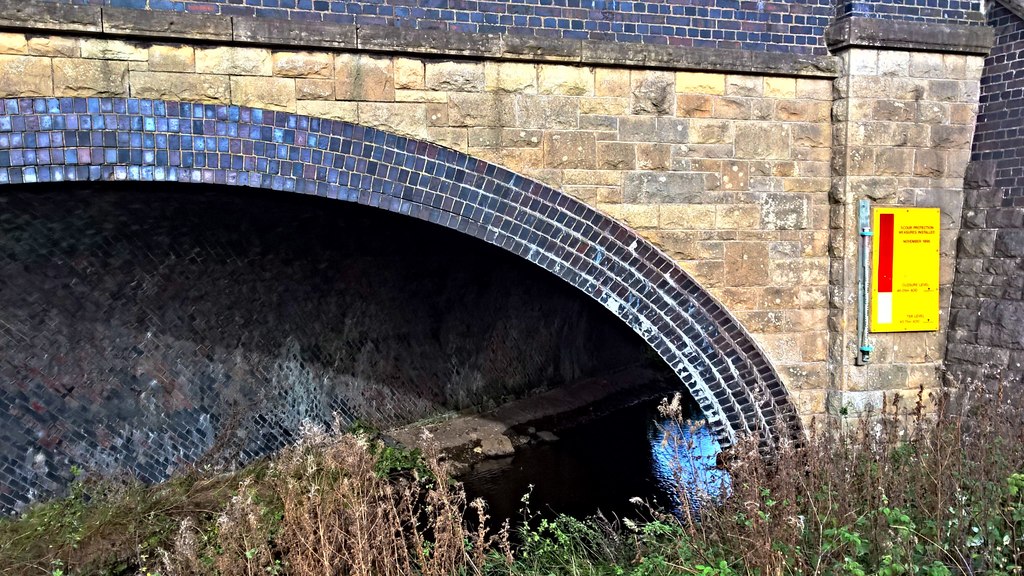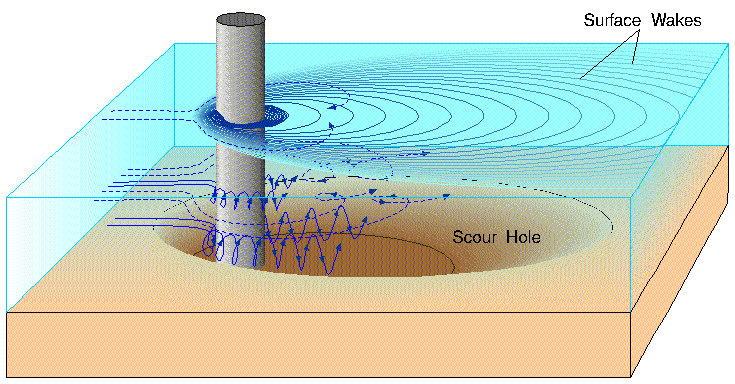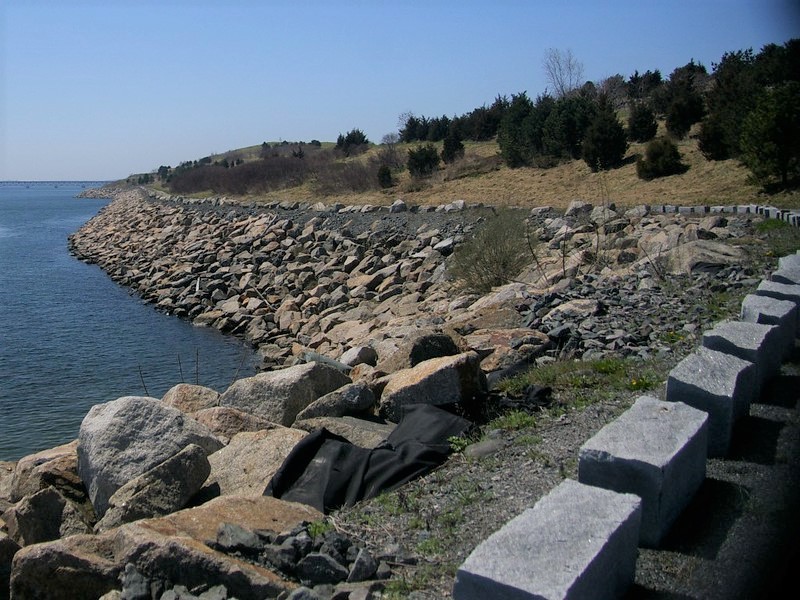Bridge scour

Scour protection measures installed November 1996, viewed from footpath alongside.
Contents |
[edit] Introduction
Bridges are one of the key elements of civil engineering. The basic principles of bridge design are dependent on the load-bearing structure, which relies on stable foundations.
There are a very wide range of construction methods available, however, bridge foundations constructed in water will usually involve the use piers or abutments. Scour is an engineering term used to describe what happens when holes (also known as scour holes) are caused by active water currents that occur around bridge piers or abutments. When severe erosion of the material at the base of the supporting structure takes place, scour can lead to structural failure of the bridge.
[edit] How scour happens
When bridge foundations are put into place into riverbeds or streams, the piers and abutments will often cause the water to move faster - creating contraction scour and altering the water’s flow. Over time, this change in flow can trigger degradation scour of the underlying surface, resulting in erosion that can lower the river bed or stream bed.
Piers and abutments are not the only things that can create changes in water currents that result in scour. If debris collects under a bridge or around its foundations, this can also create local scour. While this may not directly affect the structural integrity of the bridge, it can generate scour elsewhere and trigger a negative chain reaction as a result of the redirected water flow.
Loose soil usually causes the most common problems associated with bridge scour. However, man-made changes to the surrounding environment as a result of urbanisation can also trigger scour. The demand for natural resources and the increase in human activity (including debris) can alter water levels and currents. Flooding can also result in scour.
[edit] Predicting scour
There have been many laboratory experiments devoted to establishing equations that can calculate scour. Piers and abutments are central to some of the studies, along with types of sediment, water flow rates and so on.
Work by hydrologists and hydraulic technicians in this area is important, since it can determine the viability of a bridge placed in certain locations. On site inspections record river flow and other geological details.
For existing structures, measurements are gathered and bridges are ranked based on their scour risk. This may result in the creation of a scour plan of action that includes monitors or sensors along with precautions to take if the safety of the bridge becomes compromised.
[edit] HEC-18
In the United States, Hydraulic Engineering Circular 18 (HEC-18) provides documentation that outlines best practices for the design, evaluation and inspection of bridges for scour. There are also two supplementary documents: Stream Stability at Highway Structures (HEC-20) and Bridge Scour and Stream Instability Countermeasures (HEC-23).
Published by the Federal Highway Administration (FHWA), these manuals include additional information about estimating scour depth. However, there is some research that questions the reliability of HEC-18 due to its use of sand sediment and not other more commonly found soil materials such as compact till, stiff clay and shale.
[edit] Preventing scour
There are several techniques to prevent (or at least reduce) the occurrence of scour.
[edit] Riprap (shot rock, rock armor or rubble)
This term describes large stones, concrete blocks or even construction debris placed by engineers on shorelines that are adjacent to bridges. This is the most common form of scour remediation, although it is not deemed entirely reliable by the Federal Highway Administration under HEC-18 and 23.
Part of the riprap seawall that helps control erosion.
[edit] Channels
Angled channels can minimise corners that cause damaging water flow patterns that can create local scour.
[edit] Training structures (spur dikes, barbs, groynes, vanes)
Engineering structures situated on the river bank can be used to redirect the flow of the water and control undesirable patterns.
[edit] Piles and deep footings
These can reinforce the bridge to strengthen it and prevent damage from scour.
Some of the other containment methods include bend way weirs, gabions, mattresses, grout/cement filled bags, guide banks, check dams, drop structures and revetments.
[edit] Bridge collapses associated with scour
Bridge scour is an ongoing issue and a major cause of bridge failure. In the United States it is estimated that more than half of bridge failures are caused (at least partially) by scour. It is the most common cause of highway bridge failure in the country.
In the United Kingdom, catastrophic bridge collapses are relatively uncommon. However, since the 1840s, scour related structural failures have been linked to approximately 15 deaths.
In October 1987, a tragic incident took place in Wales. Scour as a result of significant flooding resulted in the collapse of the Glanrhyd railway bridge, causing a train to fall into the River Towy. Three passengers and three crew members were able to escape, but there were four fatalities, including the train's driver and three passengers. Following this incident railway bridge inspection practises were revised.
More recently, scour was linked to other bridge failures, including:
- June 2002: The Lower Ashenbottom viaduct in Lancashire (caused by torrential rain).
- Summer 2009: Seven road and foot bridges in Cumbria (due to flooding), resulting in one fatality.
[edit] Related articles on Designing Buildings
- Abutments.
- Assessing bridges.
- Braced frame.
- Bridge construction.
- Bridge structures.
- Caissons.
- Civil engineer.
- Counterweights.
- On the road to ruin - How America's infrastructure is failing.
- Piers.
- Pile foundations.
- Prestressed concrete.
- Railway engineering.
- River engineering.
- Structural engineer.
- Underwater foundations.
Featured articles and news
RTPI leader to become new CIOB Chief Executive Officer
Dr Victoria Hills MRTPI, FICE to take over after Caroline Gumble’s departure.
Social and affordable housing, a long term plan for delivery
The “Delivering a Decade of Renewal for Social and Affordable Housing” strategy sets out future path.
A change to adoptive architecture
Effects of global weather warming on architectural detailing, material choice and human interaction.
The proposed publicly owned and backed subsidiary of Homes England, to facilitate new homes.
How big is the problem and what can we do to mitigate the effects?
Overheating guidance and tools for building designers
A number of cool guides to help with the heat.
The UK's Modern Industrial Strategy: A 10 year plan
Previous consultation criticism, current key elements and general support with some persisting reservations.
Building Safety Regulator reforms
New roles, new staff and a new fast track service pave the way for a single construction regulator.
Architectural Technologist CPDs and Communications
CIAT CPD… and how you can do it!
Cooling centres and cool spaces
Managing extreme heat in cities by directing the public to places for heat stress relief and water sources.
Winter gardens: A brief history and warm variations
Extending the season with glass in different forms and terms.
Restoring Great Yarmouth's Winter Gardens
Transforming one of the least sustainable constructions imaginable.
Construction Skills Mission Board launch sector drive
Newly formed government and industry collaboration set strategy for recruiting an additional 100,000 construction workers a year.
New Architects Code comes into effect in September 2025
ARB Architects Code of Conduct and Practice available with ongoing consultation regarding guidance.
Welsh Skills Body (Medr) launches ambitious plan
The new skills body brings together funding and regulation of tertiary education and research for the devolved nation.
Paul Gandy FCIOB announced as next CIOB President
Former Tilbury Douglas CEO takes helm.
UK Infrastructure: A 10 Year Strategy. In brief with reactions
With the National Infrastructure and Service Transformation Authority (NISTA).
























